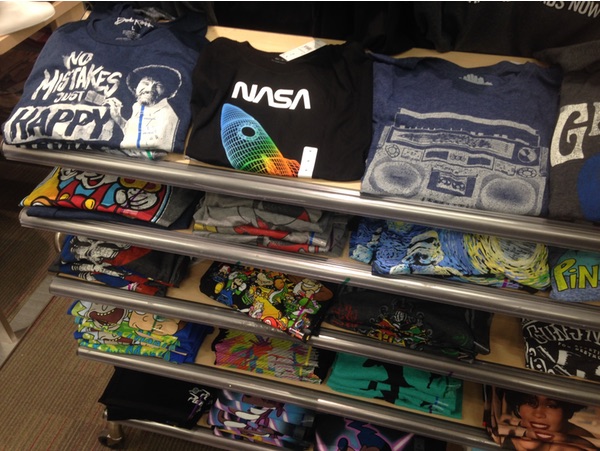NASA as a brandby Dwayne A. Day
|
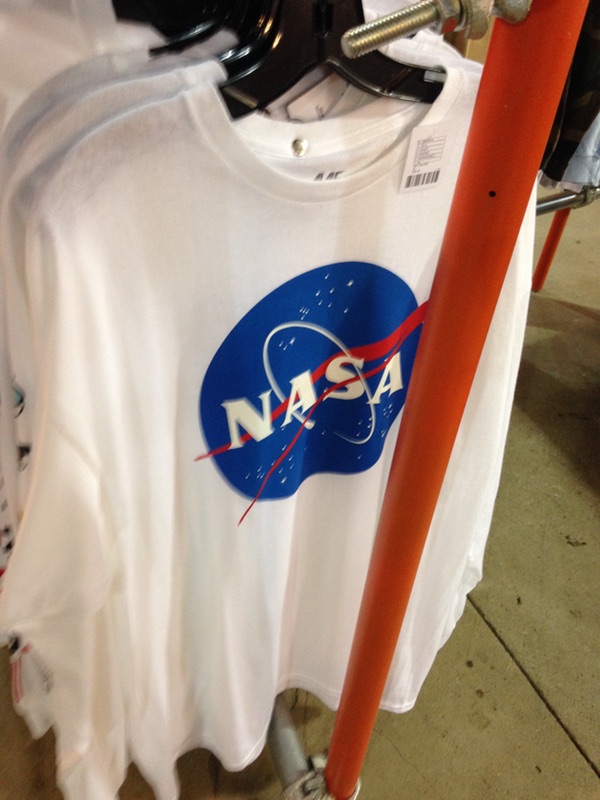 NASA t-shirts for sale at an Urban Outfitters store. (credit: D. Day) |
This is an odd development. NASA has not launched a human spacecraft from American soil in seven years. The last truly major NASA news events were the Pluto flyby in 2015 and the nail-biting Curiosity landing in 2012, both of which received worldwide publicity. Although the International Space Station has been occupied all this time, you would be hard-pressed to find a member of the American public that knows it is even up there. Back in 2012, it was common for people to believe that NASA was “going out of business” with the retirement of the space shuttle. Complicating things even further, this period of decreased public NASA activity has coincided with the ascendancy of SpaceX, particularly the launch of the Falcon Heavy rocket earlier this year, featuring the brilliant publicity stunt of placing a Tesla with a spacesuited driver on top of the rocket. For the average American, it would be easy to assume that NASA did indeed go out of business several years ago and the “space program,” to the extent that it exists, involves SpaceX shooting cars into space.
| But all these merchandizers would not be making NASA-themed apparel if they did not think there was a market for it. So why do members of the public want to buy it, especially at a time when NASA is less visible than when it was regularly launching space shuttles? |
But it’s not just t-shirts. The NASA logo has appeared on other apparel as well. I spotted a NASA-branded backpack in a novelties store. There are NASA purses and wallets and baseball caps. Even expensive NASA-branded clothing lines. And the American Girl doll company released a spacesuited astronaut doll with the NASA meatball stitched on the chest. So why all the NASA logos?
Part of this appears to be marketing. NASA logos started showing up on t-shirts for sale at Target a few years ago. In the men’s department, alongside tee-shirts for Darth Vader and Pink Floyd and Animal House, you could find a weather-beaten NASA logo t-shirt. Notably there were no t-shirts with the logos for NOAA or EPA or the US Air Force. But NASA was there, easily and affordably accessible. Last year the clothing accessories company Coach began making NASA-logo apparel like wallets and totes. In 2016, the designer Vivienne Tam adopted the NASA worm logo into a clothing line. And much more recently clothing designer Heron Preston came out with a line of NASA worm logo clothing. If you are ready to pay $326 for a designer t-shirt, $518 for a crewneck, and nearly $1,900 for a parka, you too can wear the NASA logo. Often fashion trends start with the expensive brands that are then copied by the mass-market (i.e. cheaper) manufacturers. But it appears that the mass availability provided by Target may have led the more expensive clothiers to take notice.
The NASA worm logo’s recent popularity probably traces back to the 2015 Kickstarter effort to reprint the 1976 NASA graphics standards manual that featured the worm. That fundraiser proved enormously popular and generated a lot of publicity, and websites devoted to graphic design also took notice. That project almost certainly re-introduced those graphics to designers who may have only been vaguely familiar with them, or were possibly born after the worm logo was discontinued by the space agency. Although plenty of space enthusiasts dislike the worm logo, from a graphics standpoint, that 1976 manual was bold and innovative.
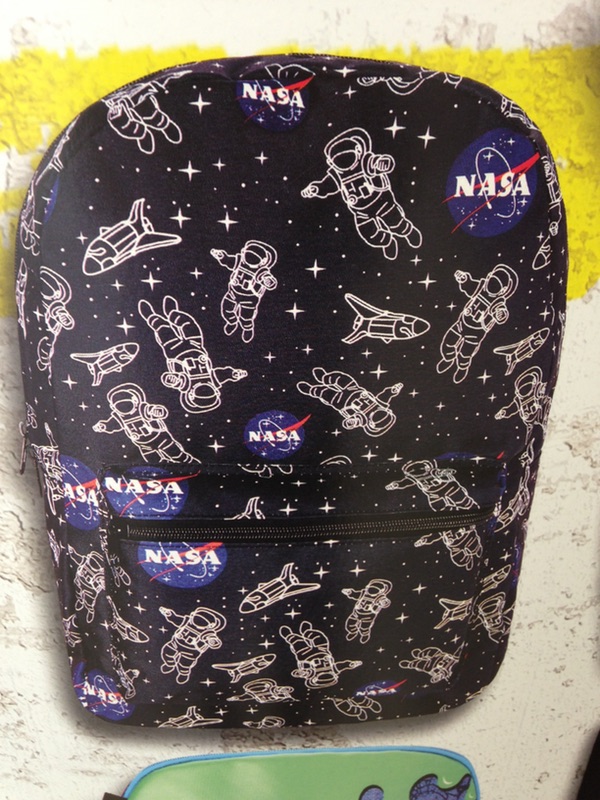 A NASA-themed backpack. (credit: D. Day) |
Fashion statements
Certainly, producing the merchandize and making it easy to purchase at places like Target has contributed to its popularity; many people will buy what is easiest to buy. But all these merchandizers would not be making NASA-themed apparel if they did not think there was a market for it. So why do members of the public want to buy it, especially at a time when NASA is less visible than when it was regularly launching space shuttles?
| The popularity of the NASA brand can probably be attributed at least in part to a couple of recent movies, The Martian in 2015 and Hidden Figures in 2016. |
Figuring this out is complicated by the fact that there’s a certain retro aspect to at least some of the products. Most of the t-shirts on sale in the men’s department at Target have a retro theme. And some of the meatball logos featured on clothing are deliberately weathered and faded, as if the logo had been sitting in the sun and wind for a few decades. When NASA initially licensed the worm logo in 2016 the agency did not impose any standards, and thus when Coach and Vivienne Tam used it, they chose colors and modifications—like outlining and rainbow patterns—that dramatically altered the logo. As a result, NASA introduced standards dictating that the worm logo had to be displayed in the context of its original use, meaning only the colors and styles like when it appeared in the 1970s: an orange worm logo on a white background, but not a pink silhouetted logo covered in sparkles. Thus, NASA has limited the worm logo to a historical context, not representing anything current or futuristic. No such restriction applies to the meatball logo.
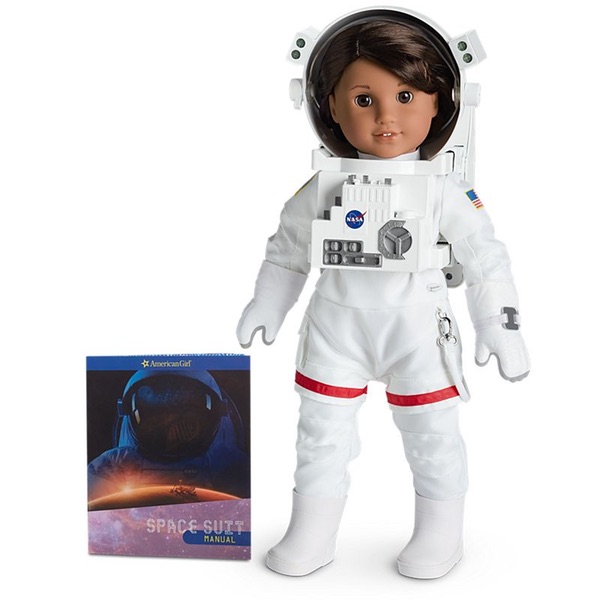 The American Girl doll company released a spacesuited astronaut doll with the NASA meatball stitched on the chest. |
This raises the question of whether the NASA logo is popular as some kind of retro chic fashion statement, like classic Coca Cola lettering or a t-shirt with “Kodak” printed on the front. Is it simply nostalgia? Could it even be that people are choosing the NASA logo as an ironic statement about a faded brand name? “We were great, once…”
It seems unlikely that many of the people wearing the NASA logo are even aware of NASA’s history or are conscious of making some kind of statement. It’s unlikely that they are thinking of “classic NASA” in their clothing choices. Even if they were, are they thinking in terms of the 1980s NASA space shuttles—and the Hubble Space Telescope—with the worm logo? Why not the 1960s NASA of Gemini and Apollo missions with the meatball? It is more likely that the people buying and wearing these clothes are not putting much conscious thought into their choices. The explanation is probably less ironic than timeless.
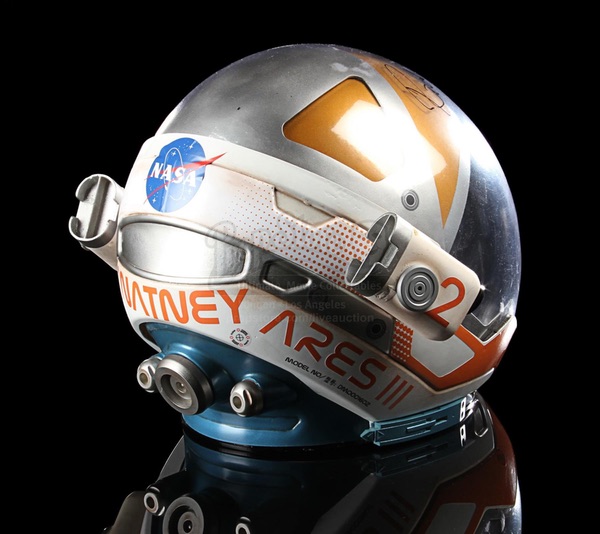 A helmet from the movie The Martian with the NASA logo and NASA worm-like lettering. |
The NASA brand on the big screen
The popularity of the NASA brand can probably be attributed at least in part to a couple of recent movies, The Martian in 2015 and Hidden Figures in 2016. The Martian had Mark Watney stranded on Mars wearing a spacesuit with the NASA meatball logo on it, and lettering in a font similar to the worm logo. Hidden Figures was filmed at a NASA facility, and the meatball logo appeared on at least one building in several scenes. So in recent years we had a futuristic action movie and a historical social message movie exposing the NASA brand to a broad swath of the population in very different—albeit positive—contexts. What those movies help demonstrate is that the NASA brand can be simultaneously nostalgic and futuristic, patriotic and apolitical.
| A decade ago, NASA administrator Michael Griffin was fond of saying that when he traveled abroad and told people he ran NASA, he received excited smiles and praise. He could be in Romania or Japan or Pakistan, it didn’t matter; everybody liked NASA. |
NASA has a long and universal coolness factor. Set aside the occasional space shuttle accident or cost overrun, NASA mostly gets into the news for doing unique and cool things, and even the things NASA did 50 years ago, like landing on the Moon, still seem amazing today. The Hubble Space Telescope is probably one of the few scientific instruments that is popularly known and well-admired, and the fact that it is still producing amazing imagery today makes it difficult to comprehend that Hubble is actually 1970s technology that was launched into space 28 years ago. NASA has landed rovers on Mars, both by bouncing them down on airbags and suspending one of them under a flying skycrane. It is about to launch a spacecraft to dive close to the Sun. Compared to the everyday activities of most industries, not to mention government agencies, NASA does exciting things. Few people get terribly excited when NOAA counts fish populations or even tracks a hurricane, or when the Department of Energy fires up a particle accelerator or introduces a new supercomputer. Landing men on the Moon is cool, flying a spacecraft around Jupiter is cool, exploring Pluto is cool, bouncing a rover down on Mars is cool. Even if some of these things happened decades ago, they seem just as cool today, even if some of the shine has worn off.
In addition to a positive domestic reputation, NASA also has global name recognition. A decade ago, NASA administrator Michael Griffin was fond of saying that when he traveled abroad and told people he ran NASA, he received excited smiles and praise. He could be in Romania or Japan or Pakistan, it didn’t matter; everybody liked NASA. It was the one US government agency that was admired and liked, even revered, around the world. NASA is viewed by people outside the United States as symbolic of the best the country can do: bold actions, and leadership in science and technology. The only bootprints on the Moon are American, the only rovers on Mars were put there by NASA, and Pluto is known as a mysterious, complex world and not a blurry dot because a NASA spacecraft flew there. That is why a child cheering a soccer game in Moscow was wearing the NASA logo.
Note: we are temporarily moderating all comments subcommitted to deal with a surge in spam.
